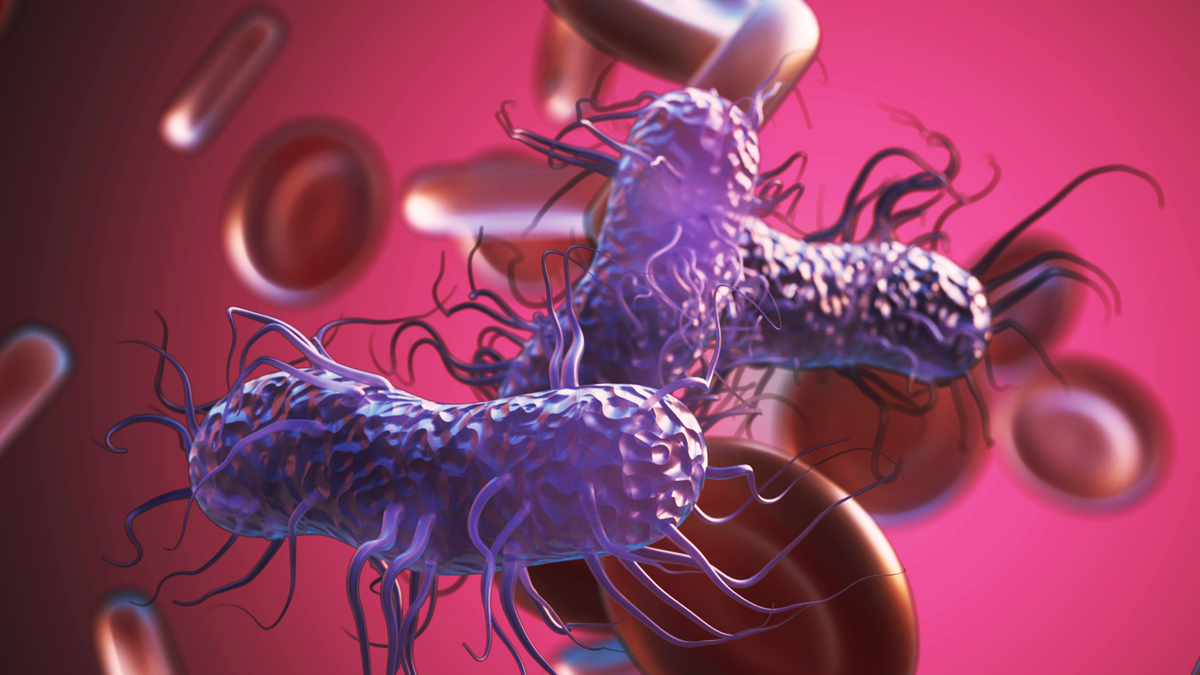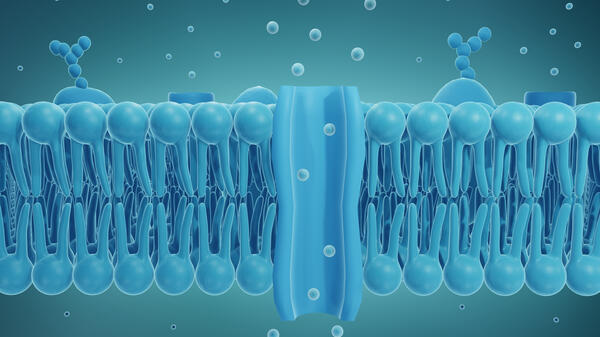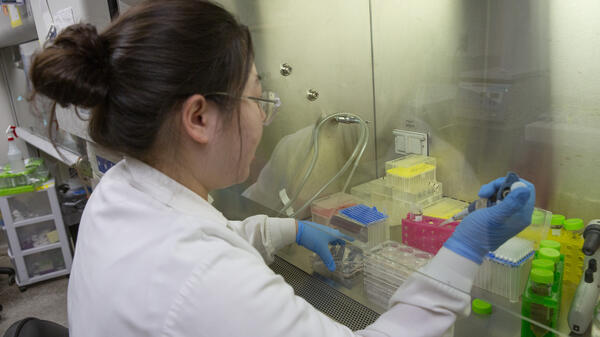ASU researchers gain insight into how a deadly strain of salmonella fine-tunes its infection tactics
Professor Cheryl Nickerson, colleagues find mechanical forces drive pathogen adaption

Salmonella typhimurium ST313 strain D23580 (pictured above in purple) has been linked to highly invasive infections. Unlike other strains that primarily cause gastroenteritis, D23580 often leads to severe and fatal systemic infections, including in the bloodstream. A new study including ASU researchers explores the effects of fluid shear in guiding the pathogen's behavior. Graphic by Jason Drees
Disease-causing microbes have evolved sophisticated strategies for invading the body, flourishing in often hostile environments and evading immune defenses.
In a new study, Professor Cheryl Nickerson, her Arizona State University colleagues and collaborators at the University of Cincinnati and NASA Johnson Space Center delve into the physical forces guiding this behavior in a multidrug-resistant strain of salmonella, a bacterial pathogen. Their insights may accelerate the design of new therapies to address life-threatening bacterial infections, such as sepsis.
The study, which appears in the journal Gut Microbes, investigates how pathogens like salmonella change their disease characteristics under fluid shear conditions like those they encounter in our bodies during infection. Fluid shear is the mechanical force caused by fluid flow, such as along the walls of blood vessels or over the surfaces of cells in the intestine. Fluid shear can influence how bacteria behave and interact with host cells during infection in ways that are not predicted when these organisms are grown under traditional laboratory conditions.
For example, fluid shear can affect the ability of bacteria like salmonella to adhere to and invade host tissues, which can play a crucial role in the development and progression of disease. Despite their importance, the effects of physical dynamics, including fluid shear on cell behavior, remain largely unexplored.
The researchers used mathematical modeling and laboratory investigations of bacterial cultures to study how the genes and disease-causing traits of multidrug-resistant salmonella typhimurium change under different physiological fluid shear environments. The conditions produced in the laboratory experiments mimic the transition of bacteria during their journey from the intestinal tract to the bloodstream, causing often fatal blood infections known as sepsis.
“The serious health risk of blood-borne infections has been exacerbated by the rapidly increasing rate of antimicrobial resistance in pathogens, creating a 'perfect storm' that has significantly increased morbidity and mortality worldwide,” according to Nickerson, a professor with the Biodesign Center for Fundamental and Applied Microbiomics and the School of Life Sciences at ASU.
Combatting a global threat
There are more than 2,600 different types of salmonella. While these bacteria are notorious for producing food-borne illnesses, only a subset are known to cause infections in humans, which they do with impressive frequency.
Salmonella is one of the leading causes of gastrointestinal diseases worldwide. According to the World Health Organization, nontyphoidal salmonella infections result in nearly 94 million cases of gastroenteritis and approximately 155,000 deaths annually. In the United States alone, the Centers for Disease Control and Prevention estimates that salmonella causes about 1.35 million infections, 26,500 hospitalizations and 420 deaths every year.
Salmonella typhimurium ST313 strain D23580, the pathogen investigated in the study, has been linked to highly invasive infections in sub-Saharan Africa and elsewhere. Unlike other S. typhimurium strains that primarily cause gastroenteritis, D23580 often leads to severe and fatal systemic infections, including in the bloodstream. This dangerous strain is also resistant to many antibiotic drug treatments, which contributes to higher morbidity and mortality rates.
S. typhimurium ST313 infections are also more likely to cause invasive disease than classic gastrointestinal disease-causing S. typhimurium strains, leading to sepsis and severe illness, especially in immunocompromised individuals, such as those with HIV or malaria, and young children.
Sepsis is a life-threatening response to infection caused by a wide range of bacteria, viruses, fungi and parasites. According to the World Health Organization, there were approximately 49 million cases of sepsis in 2020, resulting in 11 million deaths, which accounts for about 20% of all global deaths. This makes sepsis a significant global health issue, even more deadly than some other major conditions like cancer and coronary disease.
Understanding the biology and epidemiology of ST313 strains like D23580 is critical for developing targeted interventions, improving diagnostic methods and designing effective treatments and vaccines to combat infections.
"By integrating mathematical modeling, microbiology and biophysics, this study advances our understanding of how mechanical forces relevant to those encountered by microbes in the infected host may influence infection outcomes, including those that lead to sepsis, and offers a more holistic approach for the study of host-microbe systems biology,” says lead author Jiseon Yang.
'A silent risk' in the bloodstream
Although sepsis is the third leading cause of death worldwide, there is little understanding of the mechanisms responsible for this deadly disease. This has resulted in a lack of efficacious therapeutic treatments. This is due, in part, to studying sepsis-inducing pathogens under traditional laboratory conditions that fail to replicate the physiological fluid shear forces that microbes normally encounter in the body during their transition from infected tissues to the bloodstream. In addition, the rapid increase in antimicrobial resistance of bacterial pathogens presents a real threat to the treatment of sepsis, as it reduces the number of treatments available for sepsis patients.
To explore fluid shear forces, the researchers used a device called a rotating wall vessel bioreactor to culture S. typhimurium strain D23580. The specialized bioreactor was modified by the researchers to simulate a broader range of fluid shear conditions that microorganisms like bacteria will encounter in the body.
Using this approach, the researchers simulated and quantitated different fluid shear conditions, ranging from the low fluid shear experienced by bacteria in the intestinal tract to high fluid shear in the bloodstream during sepsis.
“In many ways, the health threat of septic infections represents a silent risk that has killed more people in the past two decades than COVID-19. Accordingly, we specifically designed this study to gain new insight into the mechanisms of sepsis to develop more effective therapeutic treatments,” Nickerson says.
The research is the first to demonstrate that incremental changes in fluid shear forces alter stress responses, survival in immune cells called macrophages, colonization of human intestinal cells and global gene expression in any ST313 strain, providing insight into how fluid shear forces encountered by bacteria during infection might impact their ability to survive and cause disease.
The study represents a milestone in the ongoing quest to understand how mechanical forces like fluid shear help guide and regulate bacteria during infection — a field Nickerson and her colleagues helped lay the foundation for over two decades ago.
More Science and technology

Chilling discovery: Cold-sensing protein may pave the way for safer pain relief
For millions of people worldwide who live with chronic pain, the only treatments currently available often rely on opioids, which carry the risks of addiction and overdose. However, new research…

Harnessing benefits of stem cells for heart regeneration
Mehdi Nikkhah, an associate professor of biomedical engineering in the Ira A. Fulton Schools of Engineering at Arizona State University, and his collaborators at Mayo Clinic in Arizona have been…

Newly accredited ASU summer program opens up STEM opportunities for underrepresented students
It was Monday afternoon. Spotify was playing pop music in the background and the instructor stood behind a lectern wearing a paper Burger King crown. It is not a scene one would expect in a college…

